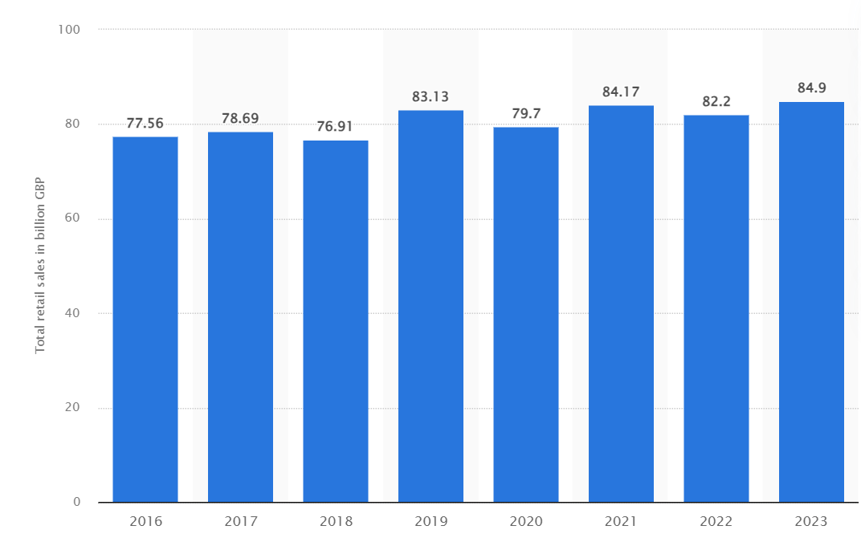
Seasonality can prove tricky when it comes to shifting time-sensitive stock. However, with the right timing and management, stocking seasonally can bring in big money for your business. For the purposes of this blog, we’ll be discussing the management of seasonal stock alongside year-round permanent stock.
On this page
- The benefits of selling seasonal stock
- Crunching the numbers
- Tips for seasonal inventory management
- Monitor inventory metrics
- Improve your forecasting
- Make use of down-season sales
- Bundle products together
- Practice a seasonal inventory management method that works for you
- Consider taking pre-orders
- Timing is everything
The benefits of selling seasonal stock
Cashing in on the holidays is often more of a necessity than a bonus for many businesses, with the total value of seasonal sales in the United Kingdom forecast to amount to approximately 85 billion British pounds in 2023, a slight increase of about 2.7 billion pounds from the previous year.

Beyond helping retailers make up the numbers during a crucial sales period, are there any other benefits to selling seasonal stock?
For one thing, the market for these products is well-defined, making them easier to promote to your target audience. People don’t need much convincing when it comes to buying festive decor, clothing, or food, meaning there are always going to be customers seeking out seasonal stock. The main difficulty is standing out in a crowded market.
Consider announcing teasers or sneak peeks of some of the seasonal products you’ll be offering earlier on via social media to build hype. Countdown clocks and email lists for early access on your website and social channels can play into this, too. Have fun with your marketing and get creative with all the ways you can get people excited about your offering.
The holidays also provide a predictable timeslot to plan for, with searches for ‘Christmas’ on CREOATE hitting a peak in late August, and continuing to spike throughout September. Getting seasonal stock in earlier allows retailers to test the waters regarding customer demand, while also helping to manage cash-flow, and accumulate the right amount of stock ahead of busier months closer to the holiday season when postal services are notoriously less reliable.
Crunching the numbers
In 2022, the holiday shopping season started earlier for many consumers in the United States. Meanwhile, in the UK, consumers are also feeling the pinch due to the rising cost of living, with George Weston, the CEO of Primark-owner Associated British Foods (ABF.L), telling Reuters, ‘People are spreading their Christmas purchases across three or four paydays, rather than relying on cash that they have in hand in December’. Similarly, Co CEO of M&S Katie Bickerstaffe told reporters that its customers had already bought about 30% of their clothing and homewares Christmas gifts.
"People are planning forward a little bit now," she said, highlighting the very high demand for Christmas pyjamas.
While total expected sales for retail events such as Black Friday and Cyber Monday in the UK were projected to amount to £8.74 billion in 2023, 3.9 billion of which would have been spent in stores. Unsurprisingly, generational internet natives are most likely to drop coin on Black Friday, with Gen Z having been predicted to spend up to £176 on average.
Despite statistically being the lowest earners on average of the generations old enough to work, Gen Z are expected to be the biggest spenders overall. With this being said, it’s worth ensuring that any Black Friday activity or offers you promote are foremost accessible online to tap into this lucrative demographic, as well as Millennials and Gen X.
With inflation increasingly forcing many shoppers to begin their gift shopping early, the expectation for shops to offer seasonal stock ever sooner could prove to be a blessing for retailers looking to gauge demand and re-stock accordingly in preparation for the holiday season.
Tips for seasonal inventory management
Get the most out of your seasonal stock with these handy tips for managing time-sensitive inventory.
- Monitor inventory metrics
- Improve your forecasting
- Make use of down-season sales
- Bundle products together
- Find a seasonal inventory management method that works for you
- Consider taking pre-orders
Monitor inventory metrics
Establish effective inventory management from the get-go. Gauge this by monitoring inventory metrics such as the following:
- Inventory turnover: How fast you restock products vs. how fast they sell. Low inventory turnover = too much stock. This also means fewer sales.
- ‘Days to Sell Inventory’: The average number of days it takes to sell off inventory. A high DSI suggests that your stock is harder to sell or that inventory is not managed effectively.
- Average inventory levels: An estimate of the number of units available over a specific period. You want your average inventory levels to line up with average seasonal sales.
- Total stock-outs: Several stock-outs during a season indicate poor forecasting and an increased ordering requirement.
Improve your forecasting
If you’re investing in seasonal stock for the first time, at best you’re making an educated guess. However, it may be that there are other giftable items in your stock that experience a spike during the holiday season, or around other seasonal events that you can use as a starting point.
Using and analysing historical data within your inventory system for these kinds of items can help you better plan ahead for further seasonal stock-ups.
Make use of down-season sales
Determine the best times to stock up and save by keeping track of your suppliers’ down-season sales. This way you can make savings and maximise profit.
Bundle products together
Whether you discover certain products regularly being bought together (e.g Christmas trees and decorations, wrapping paper, cards and gift labels etc.), or notice that some seasonal items are slower to sell than others, consider creating bundles of items to add value for your customers and shift more product.
You provide better value for your customers, make the same if not more profit, and ensure that as much seasonal stock is shifted as possible — it’s a win-win all around! Alternatively, you could offer free gift-wrapping options when customers spend over a certain amount, or when certain items are bought together.
Practice a seasonal inventory management method that works for you
There are several different holiday season inventory management methods you can use, but we’ll summarise just a few.
- Just-in-time inventory system (JIT): Receiving inventory in small amounts as needed, as close as possible to when they’re needed.
- First in, First out (FIFO): The stock that comes in first, is the first to be sold. I.e older inventory gets shipped to customers before new inventory.
- Last in, First out (LIFO): The opposite of the above, the last stock to come in is the first thing to be sold.
- ABC analysis: A = high-value products that generate the most profit, B = mid-tier, average sales; C = low tier, low sales. Items are ranked based on demand, cost, risk etc and ordered, stored, and distributed accordingly, prioritising the products and services that are most profitable and/or beneficial to the success of your business
- Economic Ordering Quantity: Taking into account demand, ordering cost, and holding cost when ordering inventory to ensure to most efficient ordering strategy that meets demand while minimising holding and storage costs.
Each inventory management system has its pros and cons, so as ever, see which works best for your business and the systems you already have in place.
Consider taking pre-orders
For more risky seasonal stock options that may result in dead or difficult-to-shift stock if not managed correctly, consider taking pre-orders. This is great for items like calendars, year planners and journals etc. You can then use information from your pre-orders to gauge appetite for similar seasonal products.
FAQs
How do you calculate seasonal sales fluctuations?
When calculating the success of your seasonal turnover, and figuring out which times of year your business in particular needs to prepare for, crunch your numbers using additive or multiplicative models. When using the additive model, for example, compare the average to the actual sales figure for that period. Meanwhile, in the multiplicative model, the original time series is represented as the multiplication of trend, seasonal, and irregular components.
Why is it important to manage seasonal inventory?
Seasonal stock with a normally predictable pattern of fluctuating demand can frequently undergo abrupt shifts, posing a challenge for businesses to accurately forecast necessary inventory levels. Flawed predictions can result in either excess inventory, incurring unnecessary holding costs, or insufficient stock, potentially causing stockouts and missed sales opportunities. So, using seasonality is useful when it comes to analysing the performance of your seasonal stock, as well as keeping on top of economic trends. Leverage seasonality to inform your operational decisions and retail seasonal planning, including seasonal inventory management and staffing.
Which products have seasonal demand?
Everything from stock that directly relates to seasonal holidays — think Christmas and Halloween decorations, costumes, fireworks, Easter eggs and greeting cards — to products more likely to sell during specific seasons, like jumpers, boots and outerwear in the winter, and sundresses, garden furniture, gardening tools and sunglasses in the summer.
Timing is everything
Ultimately, when it comes to managing seasonal stock, timing plays a huge part in success. For this reason, it’s more important than ever to find an inventory management system that works for you, and determine a plan for how you plan to roll out and market your seasonal stock to customers. This can include everything from your seasonal store layout, to your social media and email marketing plan for the festive season.
Browse our blog for more tips on how to manage stock and run a successful business, and follow us on Instagram for inspiration, advice and more.
Not registered with CREOATE yet? Sign up now and start selling wholesale with us today.
Read more articles:
Browse Popular Categories at CREOATE: Wholesale Jewellery | Wholesale Gifts | Wholesale Stationery | Wholesale Beauty Products | Wholesale Mugs | Wholesale Homeware | Wholesale Pet Supplies | Wholesale Gourmet Food | Wholesale Garden & Outdoor | Wholesale Baby & Kids Products
Browse Trending Collections on CREOATE: Wholesale Halloween | Wholesale Mother's Day Gifts | Wholesale Father's Day Gifts | Wholesale Valentine's Day Gifts | Wholesale Spiritual Supplies
>> View all








